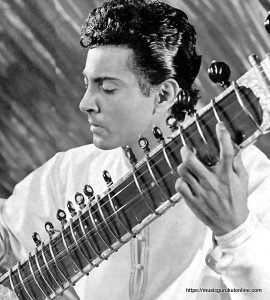An introduction to Indian Classical Music is required separately because classical music often becomes an acquired taste. In’ India, it is believed that at the origin of creation was the primordial sound, Nada Brahman. Therefore, in the heart of man, in the heart of nature, in the heart of the universe, everywhere there is harmony and music.
Introduction to Indian Classical Music

If we look around we will find that everything on earth contributes to this harmony. The laugh of a boy, the giggle of a girl, “the murmuring of the brook, the whistling of the wind, the flash of the lightning, and the crash of the thunder, all reveal to the Seer the music of creation.”
Music is a universal language that transcends all barriers of country, race, or religion. “Music can unite man to man, but even more, Music can unite man to God. Because music is the language of the soul.”
It is said that if one wants to enter into the heart of a people or a culture, one should listen to their music. And Indian music, no doubt, reflects the heart of India.
1. Hariprasad Chaurasia Flute Raga Bhopali
Indian classical music derives its special nature and character, not so much from its structure and rules, as from its quest and goal. Music, in India, has played many roles and served many purposes. It has been part of the folk tradition, it has enriched the lives of all sections of the society, it has adorned the courts of the kings. But it has never entirely forgotten its spiritual origin and nature.
There have always been musicians for whom music has not been merely entertainment or a profession. For them, it was not even a question of art for art’s sake or of music for music’s sake. It was rather a whole view of life expressed as harmony and beauty of sound. It was believed that “music is a door, beautiful to look at no doubt, but its real value lies in its opening and leading us into a new and wondrous realm.”
The Vishnu Purana declares, “All sounds are part of Him who wears a form of sound.” In the poetic words of Sri Aurobindo:
“All music is only the sound of His laughter, All beauty the smile of His passionate bliss;”
The true musician seeks to find this Being in himself and to express this Truth which underlies all creation. There is a beautiful story that has come down to us through the centuries, as part of the Indian musical tradition, and which very aptly illustrates this point.
The name of Tansen is synonymous with Indian music. He was the State musician in the court of the mighty Moghul emperor, Akbar. One day, after listening to Tansen, Akbar was so thrilled that he asked him, “Tansen, tell me who was your teacher?” “Swami Haridas, my lord,” replied Tansen. Akbar asked again, “Is he as great a musician as you are?” Tansen said very humbly, “Please, never compare me to my master.
He is not a musician but music itself.” Akbar was intrigued, “Then I would like to hear him sing.” Tansen answered, “But he will never agree to come to the court to sing.” “Then we will go to him,” said Akbar. Tansen was still diffident, “My teacher sings of his own will and he won’t be happy if he is compelled to sing before the emperor.” But Akbar was determined, “Then I will come with you, disguised as your servant.”
So, Tansen and Akbar traveled far to where the sage lived in a hut, his temple of music. The sage received Tansen, his former pupil, and his servant Akbar, with love and affection. He listened to their request but remained silent. Three days passed. Then one day, just before sunrise, Swami Haridas began to sing. Akbar and Tansen were spellbound. It seemed as if the sound had no beginning and no end, as if the trees, the stones, and all living creatures had turned into music and forgotten themselves.
After some time, when the spell was broken Akbar and Tansen found that they were alone in the hut. Swami Haridas was nowhere to be seen. “Where is he?” asked Akbar. “He has left this place forever, fearing that we may come again and trouble him,” replied Tansen sadly.
They returned to the palace, silent and indrawn. Several days passed but Akbar could never forget the effect the song had had on him. One day he asked Tansen whether he knew the Raga and the song that Swami Haridas had sung. “Yes, I learned it from him”, replied Tansen. At Akbar’s request, Tansen sat down and sang the Raga as only he could.
But Akbar’s heart was not satisfied, “Tansen, you sang beautifully. But still, why is it not the same as when Swami Haridas sang?” Tansen answered softly and humbly, “My lord, I sing for you, the emperor among men. But my master sings only for the Lord and Creator of the entire universe. Herein lies the difference.”
A simple story but with a deep meaning which reveals the true quest of Indian music, Indian Classical Music.

Indian classical music is identical in its aim and principles with all Indian art. In the revealing words of Sri Aurobindo:
“To suggest the strength and virile unconquerable force. of the divine nature in man and in the outside world, its energy, its calm, its powerful inspiration, its august enthusiasm, its wideness, greatness, attractiveness, to breathe that into man’s soul and gradually mold the finite into the image of the Infinite is [the] spiritual utility of Art. This is its loftiest function, its fullest consummation, its most perfect privilege.”
We are happy to bring to you the various dimensions of Introduction: Indian Classical Music through these programs, which seek to present its deep spiritual search as well as its technical basis. The set is titled “Alaap”, as Alap is the introductory part of a Raga and these programs serve as an introduction to Indian Classical Music, both Hindustani and Carnatic.
The illustrative pieces of music presented here are of two types. Some have been specially recorded for these programs. The others have been taken from pre-recorded pieces by some of the greatest masters of music in India. Many of these archival collections are nearly thirty to forty years old.
Therefore the technical quality of the sound is not always of a uniform standard. But our stress has always been on content and authenticity. And we have not hesitated to use these pieces because their beauty and truth have stood the test of time. For Part, I, the details of the music pieces are given as footnotes. Parts II and they after explanation of each term. The complete contents of the CDs appear at the end of the book. Every page contains numbers also as a listening guide.
We hope that through these programs you will get not only a glimpse but also a feel of Indian music, and a sense of the wonder that is India.
Download Audio :
- 01 – Sri Aurobindo Society – Alaap, Part – 1 Vol – 1 – Introduction
